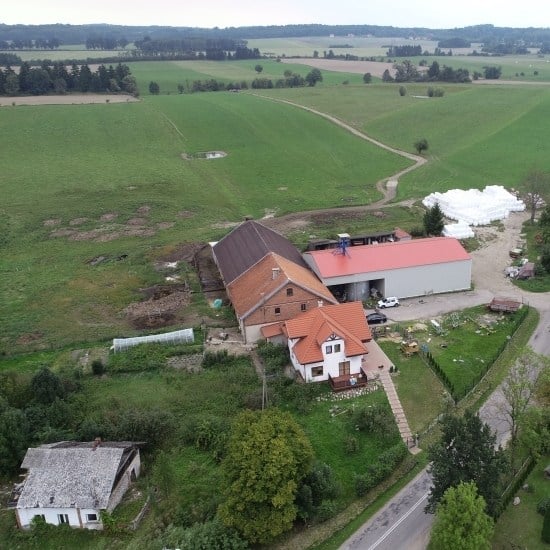The Use of the CORINE Land Cover (CLC) Database for Analyzing Urban Sprawl
Abstract
:1. Introduction
2. Background and Related Research
3. Methods and Materials
3.1. Procedure
3.2. Data
- compile harmonized information on the state of the environment with regard to certain topics which have priority for all Member States of the Community:
- coordinate the compilation of data and the organization of information within the Member States or at the international level;
- ensure that information is consistent and that data are compatible.
- Artificial surfaces—built-up areas, including residential areas, commercial and industrial areas, mines, and green urban spaces.
- Agricultural areas—arable land, permanent crops, meadows, pastures, and land principally occupied by agriculture with significant areas of natural vegetation.
- Forests and semi-natural areas—forests, shrubs and open areas with little or no vegetation.
- Wetlands—inland marshes, peatbogs, salt marshes, salines, and intertidal flats.
- Water bodies—inland waters and marine waters.
4. Results
5. Discussion
6. Conclusions
Author Contributions
Funding
Acknowledgments
Conflicts of Interest
Appendix A
| No. | Urban Area | Area [ha] in 2018 | Year of Change in Administrat-ive Boundaries | Change in Area [%] | Area [ha] of Adjacent Municipalities | Number of Adminis-trative Units |
|---|---|---|---|---|---|---|
| 1 | Warszawa | 51,724 | 189,299 | 26 | ||
| 2 | Biała Podlaska | 4940 | 104,058 | 6 | ||
| 3 | Białystok | 10,213 | 139,414 | 8 | ||
| 4 | Bielsko-Biała | 12,451 | 84,710 | 15 | ||
| 5 | Bydgoszcz | 17,598 | 174,801 | 10 | ||
| 6 | Chełm | 3528 | 95,501 | 7 | ||
| 7 | Częstochowa | 15,971 | 105,456 | 10 | ||
| 8 | Elbląg | 7982 | 98,764 | 7 | ||
| 9 | Tricity urban area | 46,431 | 166,127 | 15 | ||
| 10 | Gorzów Wielkopolski | 8572 | 97,513 | 6 | ||
| 11 | Grudziądz | 5776 | 107,937 | 9 | ||
| 12 | Jelenia Góra | 10,922 | 112,979 | 13 | ||
| 13 | Kalisz | 6942 | 97,475 | 8 | ||
| 14 | Upper Silesian urban area | 141,440 | 403,177 | 57 | ||
| 15 | Kielce | 10,965 | 119,897 | 11 | ||
| 16 | Konin | 8220 | 97,177 | 9 | ||
| 17 | Koszalin | 9834 | 2010 | 18.0 | 99,089 | 7 |
| 18 | Kraków | 32,685 | 142,849 | 17 | ||
| 19 | Krosno | 4350 | 70,726 | 10 | ||
| 20 | Legnica | 5629 | 97,083 | 8 | ||
| 21 | Leszno | 3186 | 80,100 | 6 | ||
| 22 | Lublin | 14,747 | 109,372 | 11 | ||
| 23 | Łomża | 3267 | 116,209 | 7 | ||
| 24 | Łódź | 29,325 | 158,095 | 16 | ||
| 25 | Nowy Sącz | 5758 | 64,206 | 8 | ||
| 26 | Olsztyn | 8833 | 145,151 | 7 | ||
| 27 | Opole | 14,888 | 2017 | 54.2 | 95,761 | 9 |
| 28 | Ostrołęka | 2863 | 71,378 | 5 | ||
| 29 | Piotrków Trybunalski | 6724 | 98,007 | 7 | ||
| 30 | Płock | 8804 | 116,051 | 9 | ||
| 31 | Poznań | 1351 | 136,318 | 12 | ||
| 32 | Przemyśl | 26,191 | 2010 | 5.5 | 66,544 | 7 |
| 33 | Radom | 4617 | 122,064 | 11 | ||
| 34 | Rybnik | 11,180 | 168,026 | 27 | ||
| 35 | Rzeszów | 14,836 | 2006–2017 | 76.9 | 116,904 | 13 |
| 36 | Siedlce | 12,041 | 99,932 | 8 | ||
| 37 | Skierniewice | 3186 | 2012 | 4.6 | 75,450 | 8 |
| 38 | Słupsk | 3460 | 123,343 | 6 | ||
| 39 | Suwałki | 4315 | 96,424 | 6 | ||
| 40 | Szczecin | 6551 | 173,931 | 8 | ||
| 41 | Świnoujście | 30,060 | 113,008 | 5 | ||
| 42 | Tarnobrzeg | 19,723 | 96,115 | 10 | ||
| 43 | Tarnów | 8540 | 77,071 | 9 | ||
| 44 | Toruń | 7238 | 98,921 | 7 | ||
| 45 | Wałbrzych | 11,572 | 98,377 | 13 | ||
| 46 | Włocławek | 8470 | 106,018 | 9 | ||
| 47 | Wrocław | 29,282 | 171,653 | 11 | ||
| 48 | Zamość | 3034 | 52,303 | 5 | ||
| 49 | Zielona Góra | 27,832 | 2015 | 377.1 | 177,313 | 11 |
| Total | 5,828,077 | 530 |
| No. | Urban Area | Urbanized Area 2006 (ha) | Urbanized Area 2012 (ha) | Urbanized Area 2018 (ha) | OU 2006 | OU 2012 | OU 2018 |
|---|---|---|---|---|---|---|---|
| 1 | Warszawa | 123,502 | 152,496 | 154,533 | 2.39 | 2.95 | 2.99 |
| 2 | Biała Podlaska | 5102 | 9107 | 14,878 | 1.03 | 1.84 | 3.01 |
| 3 | Białystok | 14,466 | 47,328 | 54,276 | 1.42 | 4.63 | 5.31 |
| 4 | Bielsko-Biała | 32,928 | 48,442 | 55,340 | 2.65 | 3.90 | 4.45 |
| 5 | Bydgoszcz | 18,778 | 22,500 | 42,895 | 1.07 | 1.28 | 2.44 |
| 6 | Chełm | 18,531 | 21,547 | 21,593 | 5.25 | 6.10 | 6.11 |
| 7 | Częstochowa | 36,543 | 68,872 | 69,578 | 2.29 | 4.32 | 4.36 |
| 8 | Elbląg | 3801 | 5751 | 16,047 | 0.48 | 0.72 | 2.01 |
| 9 | Gdańsk | 47,394 | 81,448 | 83,255 | 1.15 | 1.97 | 2.01 |
| 10 | Gorzów Wielkopolski | 9897 | 27,582 | 27,915 | 1.15 | 3.22 | 3.26 |
| 11 | Grudziądz | 5612 | 21,408 | 21,433 | 0.97 | 3.71 | 3.72 |
| 12 | Jelenia Góra | 10,933 | 56,798 | 57,453 | 1.00 | 5.20 | 5.26 |
| 13 | Kalisz | 40,951 | 45,476 | 47,767 | 5.91 | 6.56 | 6.89 |
| 14 | Katowice | 237,193 | 253,096 | 260,582 | 1.95 | 2.08 | 2.14 |
| 15 | Kielce | 44,589 | 73,438 | 77,506 | 4.07 | 6.70 | 7.08 |
| 16 | Konin | 16,058 | 28,283 | 30,242 | 1.96 | 3.45 | 3.69 |
| 17 | Koszalin | 9220 | 20,560 | 27,615 | 0.94 | 2.09 | 2.81 |
| 18 | Kraków | 54,517 | 116,685 | 118,896 | 1.67 | 3.57 | 3.64 |
| 19 | Krosno | 23,996 | 28,517 | 28,593 | 5.52 | 6.56 | 6.58 |
| 20 | Legnica | 22,671 | 40,088 | 54,220 | 4.03 | 7.12 | 9.64 |
| 21 | Leszno | 8711 | 27,414 | 31,752 | 2.74 | 8.61 | 9.97 |
| 22 | Lublin | 26,690 | 37,303 | 48,431 | 1.81 | 2.53 | 3.28 |
| 23 | Łomża | 3780 | 17,141 | 34,609 | 1.16 | 5.25 | 10.60 |
| 24 | Łódź | 81,830 | 91,901 | 94,813 | 2.79 | 3.14 | 3.24 |
| 25 | Nowy Sącz | 14,920 | 16,433 | 16,843 | 2.59 | 2.86 | 2.93 |
| 26 | Olsztyn | 9866 | 23,399 | 29,737 | 1.12 | 2.65 | 3.37 |
| 27 | Opole | 43,309 | 48,084 | 48,323 | 2.91 | 3.23 | 3.25 |
| 28 | Ostrołęka | 5885 | 14,596 | 19,912 | 1.76 | 4.37 | 5.96 |
| 29 | Piotrków Trybunalski | 37,823 | 41,831 | 47,414 | 5.63 | 6.23 | 7.06 |
| 30 | Płock | 7110 | 15,057 | 17,925 | 0.81 | 1.71 | 2.04 |
| 31 | Poznań | 46,385 | 78,733 | 82,310 | 1.77 | 3.01 | 3.15 |
| 32 | Przemyśl | 12,986 | 23,521 | 24,701 | 2.81 | 5.09 | 5.35 |
| 33 | Radom | 31,078 | 57,736 | 63,385 | 2.78 | 5.17 | 5.67 |
| 34 | Rybnik | 64,712 | 83,894 | 84,590 | 2.17 | 2.82 | 2.84 |
| 35 | Rzeszów | 40,380 | 57,280 | 60,669 | 3.35 | 4.76 | 5.04 |
| 36 | Siedlce | 6152 | 49,139 | 50,212 | 1.93 | 15.43 | 15.76 |
| 37 | Skierniewice | 20,380 | 35,322 | 35,527 | 5.90 | 10.22 | 10.28 |
| 38 | Słupsk | 7615 | 24,114 | 25,535 | 1.77 | 5.59 | 5.92 |
| 39 | Suwałki | 4667 | 7123 | 10,005 | 0.71 | 1.09 | 1.53 |
| 40 | Szczecin | 29,904 | 59,683 | 59,859 | 0.99 | 1.98 | 1.99 |
| 41 | Świnoujście | 3436 | 4570 | 4687 | 0.17 | 0.23 | 0.23 |
| 42 | Tarnobrzeg | 40,027 | 58,337 | 58,523 | 4.69 | 6.83 | 6.86 |
| 43 | Tarnów | 22,556 | 46,015 | 46,770 | 3.12 | 6.36 | 6.47 |
| 44 | Toruń | 15,657 | 24,025 | 28,690 | 1.35 | 2.08 | 2.48 |
| 45 | Wałbrzych | 26,800 | 40,587 | 42,716 | 3.17 | 4.80 | 5.05 |
| 46 | Włocławek | 6118 | 18,731 | 19,479 | 0.73 | 2.22 | 2.31 |
| 47 | Wrocław | 94,562 | 122,463 | 122,538 | 3.23 | 4.19 | 4.19 |
| 48 | Zamość | 14,228 | 27,098 | 27,955 | 4.69 | 8.93 | 9.21 |
| 49 | Zielona Góra | 13,937 | 30,187 | 34,731 | 0.50 | 1.08 | 1.25 |
| No. | Urban Area | OU Index 2006 | OU Index 2012 | OU Index 2018 | Population in 2017 |
|---|---|---|---|---|---|
| 1 | Warszawa | 2.39 | 2.95 | 2.99 | 1,764,615 |
| 18 | Kraków | 1.67 | 3.57 | 3.64 | 767,348 |
| 24 | Łódź | 2.79 | 3.14 | 3.24 | 690,422 |
| 47 | Wrocław | 3.23 | 4.19 | 4.19 | 638,586 |
| 31 | Poznań | 1.77 | 3.01 | 3.15 | 538,633 |
| 9 | Gdańsk | 1.15 | 1.97 | 2.01 | 464,254 |
| 40 | Szczecin | 0.99 | 1.98 | 1.99 | 403,883 |
| 5 | Bydgoszcz | 1.07 | 1.28 | 2.44 | 352,313 |
| 22 | Lublin | 1.81 | 2.53 | 3.28 | 339,850 |
| 3 | Białystok | 1.42 | 4.63 | 5.31 | 297,288 |
| 14 | Katowice | 1.95 | 2.08 | 2.14 | 296,262 |
| 7 | Częstochowa | 2.29 | 4.32 | 4.36 | 224,376 |
| 33 | Radom | 2.78 | 5.17 | 5.67 | 214,566 |
| 44 | Toruń | 1.35 | 2.08 | 2.48 | 202,562 |
| 15 | Kielce | 4.07 | 6.70 | 7.08 | 196,804 |
| 35 | Rzeszów | 3.35 | 4.76 | 5.04 | 189,662 |
| 26 | Olsztyn | 1.12 | 2.65 | 3.37 | 173,070 |
| 4 | Bielsko-Biała | 2.65 | 3.90 | 4.45 | 171,505 |
| 49 | Zielona Góra | 0.50 | 1.08 | 1.25 | 139,819 |
| 34 | Rybnik | 2.17 | 2.82 | 2.84 | 139,129 |
| 27 | Opole | 2.91 | 3.23 | 3.25 | 128,140 |
| 10 | Gorzów Wielkopolski | 1.15 | 3.22 | 3.26 | 124,295 |
| 8 | Elbląg | 0.48 | 0.72 | 2.01 | 120,895 |
| 30 | Płock | 0.81 | 1.71 | 2.04 | 120,787 |
| 45 | Wałbrzych since 2013 | 3.17 | 4.80 | 5.05 | 113,621 |
| 46 | Włocławek | 0.73 | 2.22 | 2.31 | 111,752 |
| 43 | Tarnów | 3.12 | 6.36 | 6.47 | 109,650 |
| 17 | Koszalin | 0.94 | 2.09 | 2.81 | 107,670 |
| 13 | Kalisz | 5.91 | 6.56 | 6.89 | 101,625 |
| 20 | Legnica | 4.03 | 7.12 | 9.64 | 100,324 |
| 11 | Grudziądz | 0.97 | 3.71 | 3.72 | 95,629 |
| 38 | Słupsk | 1.77 | 5.59 | 5.92 | 91,465 |
| 25 | Nowy Sącz | 2.59 | 2.86 | 2.93 | 84,041 |
| 12 | Jelenia Góra | 1.00 | 5.20 | 5.26 | 80,072 |
| 36 | Siedlce | 1.93 | 15.43 | 15.76 | 77,653 |
| 16 | Konin | 1.96 | 3.45 | 3.69 | 74,834 |
| 29 | Piotrków Trybunalski | 5.63 | 6.23 | 7.06 | 74,312 |
| 39 | Suwałki | 0.71 | 1.09 | 1.53 | 69,554 |
| 48 | Zamość | 4.69 | 8.93 | 9.21 | 64,354 |
| 21 | Leszno | 2.74 | 8.61 | 9.97 | 64,197 |
| 6 | Chełm | 5.25 | 6.10 | 6.11 | 63,333 |
| 23 | Łomża | 1.16 | 5.25 | 10.60 | 63,092 |
| 32 | Przemyśl | 2.81 | 5.09 | 5.35 | 61,808 |
| 2 | Biała Podlaska | 1.03 | 1.84 | 3.01 | 57,545 |
| 28 | Ostrołęka | 1.76 | 4.37 | 5.96 | 52,215 |
| 37 | Skierniewice | 5.90 | 10.22 | 10.28 | 48,308 |
| 42 | Tarnobrzeg | 4.69 | 6.83 | 6.86 | 47,387 |
| 19 | Krosno | 5.52 | 6.56 | 6.58 | 46,600 |
| 41 | Świnoujście | 0.17 | 0.23 | 0.23 | 41,032 |
| No. | Urban Area | Population in 2017 | Increase in OU in 2006–2012 (%) | No. | Urban Area | Population in 2017 | Increase in OU in 2012–2018 (%) |
|---|---|---|---|---|---|---|---|
| 3 | Białystok | 297,288 | 227.17 | 5 | Bydgoszcz | 352,313 | 90.65 |
| 26 | Olsztyn | 173,070 | 137.16 | 22 | Lublin | 339,850 | 29.83 |
| 18 | Kraków | 767,348 | 114.04 | 26 | Olsztyn | 173,070 | 27.09 |
| 40 | Szczecin | 403,883 | 99.58 | 44 | Toruń | 202,562 | 19.42 |
| 7 | Częstochowa | 224,376 | 88.47 | 3 | Białystok | 297,288 | 14.68 |
| 33 | Radom | 214,566 | 85.78 | 4 | Bielsko-Biała | 171,505 | 14.24 |
| 9 | Gdańsk | 464,254 | 71.85 | 33 | Radom | 214,566 | 9.78 |
| 31 | Poznań | 538,633 | 69.74 | 35 | Rzeszów | 189,662 | 5.92 |
| 15 | Kielce | 196,804 | 64.70 | 15 | Kielce | 196,804 | 5.54 |
| 44 | Toruń | 202,562 | 53.45 | 31 | Poznań | 538,633 | 4.54 |
| 4 | Bielsko-Biała | 171,505 | 47.11 | 24 | Łódź | 690,422 | 3.17 |
| 35 | Rzeszów | 189,662 | 41.85 | 14 | Katowice | 296,262 | 2.96 |
| 22 | Lublin | 339,850 | 39.76 | 9 | Gdańsk | 464,254 | 2.22 |
| 47 | Wrocław | 638,586 | 29.51 | 18 | Kraków | 767,348 | 1.89 |
| 1 | Warszawa | 1,764,615 | 23.48 | 1 | Warszawa | 1764,615 | 1.34 |
| 5 | Bydgoszcz | 352,313 | 19.82 | 7 | Częstochowa | 224,376 | 1.02 |
| 24 | Łódź | 690,422 | 12.31 | 40 | Szczecin | 403,883 | 0.29 |
| 14 | Katowice | 296,262 | 6.70 | 47 | Wrocław | 638,586 | 0.06 |
| 12 | Jelenia Góra | 80,072 | 419.50 | 8 | Elbląg | 120,895 | 179.03 |
| 11 | Grudziądz | 95,629 | 281.49 | 20 | Legnica | 100,324 | 35.25 |
| 38 | Słupsk | 91,465 | 216.65 | 17 | Koszalin | 107,670 | 34.32 |
| 46 | Włocławek | 111,752 | 206.18 | 30 | Płock | 120,787 | 19.05 |
| 10 | Gorzów Wielkopolski | 124,295 | 178.68 | 49 | Zielona Góra | 139,819 | 15.05 |
| 17 | Koszalin | 107,670 | 122.99 | 38 | Słupsk | 91,465 | 5.89 |
| 49 | Zielona Góra | 139,819 | 116.60 | 45 | Wałbrzych | 113,621 | 5.25 |
| 30 | Płock | 120,787 | 111.77 | 13 | Kalisz | 101,625 | 5.04 |
| 43 | Tarnów | 109,650 | 104.00 | 46 | Włocławek | 111,752 | 3.99 |
| 20 | Legnica | 100,324 | 76.82 | 25 | Nowy Sącz | 84,041 | 2.49 |
| 45 | Wałbrzych | 113,621 | 51.44 | 43 | Tarnów | 109,650 | 1.64 |
| 8 | Elbląg | 120,895 | 51.28 | 10 | Gorzów Wielkopolski | 124,295 | 1.21 |
| 34 | Rybnik | 139,129 | 29.64 | 12 | Jelenia Góra | 80,072 | 1.15 |
| 13 | Kalisz | 101,625 | 11.05 | 34 | Rybnik | 139,129 | 0.83 |
| 27 | Opole | 128,140 | 11.03 | 27 | Opole | 128,140 | 0.50 |
| 25 | Nowy Sącz | 84,041 | 10.14 | 11 | Grudziądz | 95,629 | 0.12 |
| 36 | Siedlce | 77,653 | 698.80 | 23 | Łomża | 63,092 | 101.91 |
| 23 | Łomża | 63,092 | 353.39 | 2 | Biała Podlaska | 57,545 | 63.36 |
| 21 | Leszno | 64,197 | 214.70 | 39 | Suwałki | 69,554 | 40.47 |
| 28 | Ostrołęka | 52,215 | 148.03 | 28 | Ostrołęka | 52,215 | 36.42 |
| 48 | Zamość | 64,354 | 90.46 | 21 | Leszno | 64,197 | 15.83 |
| 32 | Przemyśl | 61,808 | 81.13 | 29 | Piotrków Trybunalski | 74,312 | 13.35 |
| 2 | Biała Podlaska | 57,545 | 78.51 | 16 | Konin | 74,834 | 6.92 |
| 16 | Konin | 74,834 | 76.13 | 32 | Przemyśl | 61,808 | 5.02 |
| 37 | Skierniewice | 48,308 | 73.32 | 48 | Zamość | 64,354 | 3.16 |
| 39 | Suwałki | 69,554 | 52.63 | 36 | Siedlce | 77,653 | 2.18 |
| 42 | Tarnobrzeg | 47,387 | 45.74 | 41 | Świnoujście | 41,032 | 2.12 |
| 41 | Świnoujście | 41,032 | 33.00 | 37 | Skierniewice | 48,308 | 0.58 |
| 19 | Krosno | 46,600 | 18.84 | 42 | Tarnobrzeg | 47,387 | 0.32 |
| 6 | Chełm | 63,333 | 16.28 | 19 | Krosno | 46,600 | 0.27 |
| 29 | Piotrków Trybunalski | 74,312 | 10.60 | 6 | Chełm | 63,333 | 0.22 |
| Name | Urban Area | Increase in OU 06-12 | Increase in OU 12-18 | Population Increase 06-12 | Population Increase 12-18 |
|---|---|---|---|---|---|
| 1 | Warszawa | 0.23 | 0.01 | 3.33 | 3.73 |
| 18 | Kraków | 1.14 | 0.02 | 2.78 | 2.54 |
| 24 | Łódź | 0.12 | 0.03 | −3.19 | −2.55 |
| 47 | Wrocław | 0.30 | 0.00 | 2.95 | 3.45 |
| 31 | Poznań | 0.70 | 0.05 | 3.75 | 2.81 |
| 9 | Gdańsk | 0.72 | 0.02 | 3.67 | 2.70 |
| 40 | Szczecin | 1.00 | 0.00 | 2.25 | 0.20 |
| 5 | Bydgoszcz | 0.20 | 0.91 | 2.45 | −0.29 |
| 22 | Lublin | 0.40 | 0.30 | 0.76 | −0.43 |
| 3 | Białystok | 2.27 | 0.15 | 2.15 | 1.92 |
| 14 | Katowice | 0.07 | 0.03 | −2.21 | −2.04 |
| 7 | Częstochowa | 0.88 | 0.01 | −2.01 | −2.67 |
| 33 | Radom | 0.86 | 0.10 | −0.15 | −0.67 |
| 44 | Toruń | 0.53 | 0.19 | 1.77 | 1.29 |
| 15 | Kielce | 0.65 | 0.06 | 5.05 | −0.12 |
| 35 | Rzeszów | 0.42 | 0.06 | 4.18 | 3.71 |
| 26 | Olsztyn | 1.37 | 0.27 | 3.02 | 1.25 |
| 4 | Bielsko-Biała | 0.47 | 0.14 | 1.96 | 0.71 |
| 49 | Zielona Góra | 1.17 | 0.15 | 1.30 | 8.34 |
| 34 | Rybnik | 0.30 | 0.01 | 0.68 | −0.22 |
| 27 | Opole | 0.11 | 0.00 | −2.69 | −1.03 |
| 10 | Gorzów Wielkopolski | 1.79 | 0.01 | 1.78 | 0.89 |
| 8 | Elbląg | 0.51 | 1.79 | −0.77 | −1.72 |
| 30 | Płock | 1.12 | 0.19 | 0.29 | −0.68 |
| 45 | Wałbrzych since 2013 | 0.51 | 0.05 | −1.72 | −3.42 |
| 46 | Włocławek | 2.06 | 0.04 | −0.82 | −2.13 |
| 43 | Tarnów | 1.04 | 0.02 | 0.05 | −0.40 |
| 17 | Koszalin | 1.23 | 0.34 | 2.34 | −0.19 |
| 13 | Kalisz | 0.11 | 0.05 | −0.67 | −0.91 |
| 20 | Legnica | 0.77 | 0.35 | 1.37 | 0.32 |
| 11 | Grudziądz | 2.81 | 0.00 | 0.83 | −0.91 |
| 38 | Słupsk | 2.17 | 0.06 | 1.05 | −0.29 |
| 25 | Nowy Sącz | 0.10 | 0.02 | 3.45 | 1.88 |
| 12 | Jelenia Góra | 4.19 | 0.01 | −1.40 | −2.50 |
| 36 | Siedlce | 6.99 | 0.02 | 0.97 | 1.43 |
| 16 | Konin | 0.76 | 0.07 | 0.92 | −0.57 |
| 29 | Piotrków Trybunalski | 0.11 | 0.13 | −0.82 | −1.36 |
| 39 | Suwałki | 0.53 | 0.40 | 1.26 | 0.40 |
| 48 | Zamość | 0.90 | 0.03 | 0.72 | −0.66 |
| 21 | Leszno | 2.15 | 0.16 | 2.86 | 0.80 |
| 6 | Chełm | 0.16 | 0.00 | −0.94 | −2.27 |
| 23 | Łomża | 3.53 | 1.02 | 0.77 | −0.19 |
| 32 | Przemyśl | 0.81 | 0.05 | −0.25 | −1.43 |
| 2 | Biała Podlaska | 0.79 | 0.63 | 0.65 | −0.39 |
| 28 | Ostrołęka | 1.48 | 0.36 | 2.01 | 0.82 |
| 37 | Skierniewice | 0.73 | 0.01 | 0.53 | −0.06 |
| 42 | Tarnobrzeg | 0.46 | 0.00 | −1.11 | −2.03 |
| 19 | Krosno | 0.19 | 0.00 | 1.10 | −0.14 |
| 41 | Świnoujście | 0.33 | 0.02 | 1.82 | −1.19 |
References
- Cieślak, I. Identification of areas exposed to land use conflict with the use of multiple-criteria decision-making methods. Land Use Policy 2019, 89, 104225. [Google Scholar] [CrossRef]
- Lisowski, A. Problems with the contemporary identification of the concept of ‘suburbanization’. In Urban Agglomerations in Poland at the Turn of the 20th and 21st Centuries: Problems of Development of Structural Transformations and Functioning; Maik, W., Ed.; Wydawnictwo Uczelniane WSG: Bydgoszcz, Poland, 2009; pp. 59–72. (In Polish) [Google Scholar]
- Glaeser, E.; Kahn, M.E. Sprawl and Urban Growth NBER Working Paper Series 2003. Working Paper 9733. Available online: http://www.nber.org/papers/w9733 (accessed on 1 November 2019).
- Crisci, M.; Gemmiti, R.; Proietti, E.; Violante, A. Urban Sprawl e Shrinking Cities in Italia. Trasformazione Urbana e Redistribuzione della Popolazione nelle Aree Metropolitan; CNR-IRPPS e-Publishing: Roma, Italy, 2014. [Google Scholar]
- EEA Report. Urban Sprawl in Europe—The Ignored Challenge; Report No 10/2006; European Environment Agency: Copenhagen, Denmark, 2006. Available online: http://www.eea.europa.eu/publications/eea_report_2006_10 (accessed on 12 November 2019).
- Zuziak, Z.K. Suburban area in the city’s architecture: Towards the new architecture of the urban region. In The Problem of Suburbanization; Lorens, P., Ed.; Biblioteka Urbanisty: Warsaw, Poland, 2005; pp. 17–32. (In Polish) [Google Scholar]
- Kociuba, D. Limitations in urban development in the context of spatial planning, (Ograniczenia w rozwoju miast w kontekście planowania przestrzennego). Studia KPZK PAN 2015, 161, 112–122. (In Polish) [Google Scholar]
- Śleszyński, P.; Deręgowska, A.; Kubiak, Ł.; Sudra, P.; Zielińska, B. Analysis of the State and Conditions of Planning Work in Municipalities in 2017; Instytut Geografii i Przestrzennego Zagospodarowania PAN na zlecenie Ministerstwa Inwestycji i Rozwoju: Warsaw, Poland, 2018. (In Polish) [Google Scholar]
- Cieślak, I.; Czyża, S.; Szuniewicz, K.; Ogrodniczak, M. Assessment of Residential Areas of City on the Example of Olsztyn. In IOP Conference Series: Materials Science and Engineering; IOP Publishing: Bristol, UK, 2019; Volume 471, p. 102001. [Google Scholar] [CrossRef]
- Borana, S.L.; Yadav, S.K. Urban Growth Analysis Using Shannon’s Entropy: A Case Study of Jodhpur City. Int. J. 2017, 5, 50–57. [Google Scholar]
- Hassea, J.; Lathrop, R. Land resource impact indicators of urban sprawl. Appl. Geogr. 2003, 23, 159–175. [Google Scholar] [CrossRef]
- Zagajewski, B.; Jarocińska, A.; Olesiuk, D. Methods and Techniques of Geoinformatic Research (Metody i Techniki Badań Geoinformatycznych); Wydział Geografii i Studiów Regionalnych UW: Warsaw, Poland, 2009; pp. 1–117. (In Polish) [Google Scholar]
- Pelorosso, R.; Leone, A.; Boccia, L. Land cover and land use change in the Italian central Apennines: A comparison of assessment methods. Appl. Geogr. 2009, 29, 35–48. [Google Scholar] [CrossRef]
- Cieślak, I.; Szuniewicz, K.; Czyża, S. Analysis of the Variation of the Areas under Urbanization Pressure Using Entropy Index. Procedia Eng. 2016, 161, 2001–2005. [Google Scholar] [CrossRef] [Green Version]
- Ustaoglu, E.; Aydınoglu, A.C. Regional Variations of Land-Use Development and Land-Use/Cover Change Dynamics: A Case Study of Turkey. Remote Sens. 2019, 11, 885. [Google Scholar] [CrossRef] [Green Version]
- Grigorescu, I.; Kucsicsa, G.; Popovici, E.; Mitrică, B.; Dumitrașcu, M.; Mocanu, I. Regional disparities in the urban sprawl phenomenon in Romania using CORINE land cover database. Rom. J. Geogr. 2018, 62, 169–184. [Google Scholar]
- Bathrellos, G.D.; Skilodimou, H.D.; Chousianitis, K.; Youssef, A.M.; Pradhan, B. Multi-hazard assessment modeling via multi-criteria analysis and GIS: A case study. Sci. Total Environ. 2017, 575, 119–134. [Google Scholar] [CrossRef]
- Jucha, W.; Kroczak, R. Comparison of land use data from the CORINE Land Cover program with data obtained from orthophotomaps. In Socio-Economic and Spatial Transformation of Regional Structures; Kaczmarska, E., Raźniak, P., Eds.; Oficyna Wydawnicza AFM: Kraków, Poland, 2014; pp. 123–136. (In Polish) [Google Scholar]
- Bruegmann, R. Sprawl: A Compact History; University of Chicago Press: Chicago, IL, USA; London, UK, 2005. [Google Scholar]
- Degórska, B. Spatial Urbanization of Rural Areas in the Warsaw Metropolitan Area. Ecological and Landscape Context; Instytut Geografii I Przestrzennego Zagospodarowania PAN: Warsaw, Poland, 2017. (In Polish) [Google Scholar]
- Lewyn, M. Sprawl in Europe and America. San Diego Law Rev. 2009, 46, 85. [Google Scholar] [CrossRef] [Green Version]
- EEA Report. Urban Sprawl in Europe, Joint EEA-FOEN Report; EEA Report No. 11/2016; European Environment Agency—Publications Office of the European Union: Luxembourg, 2016; Available online: https://www.eea.europa.eu/publications/urban-sprawl-in-europe (accessed on 10 November 2019).
- Kudłacz, M. Dysfunctions of amorphous settlement growth in Poland. Studia Ekonomiczne 2016, 279, 245–257. (In Polish) [Google Scholar]
- Leontidou, L.; Afouxenidis, A.; Kourliouros, E.; Marmaras, E. Infrastructure related urban sprawl: Mega-events and hybrid peri-urban landscapes in Southern Europe. In Urban Sprawl in Europe: Landscape, Land-Use Change and Policy; Couch, C., Leontidou, L., Petschel-Held, G., Eds.; Blackwell Publishing: Hoboken, NJ, USA, 2007; pp. 71–101. [Google Scholar]
- Jaeger, J.A.G.; Schwick, C. Improving the measurement of urban sprawl: Weighted Urban Proliferation (WUP) and Its application to Switzerland. Ecol. Indic. 2014, 38, 294–308. [Google Scholar] [CrossRef]
- Zhao, P. Managing urban growth in a transforming China: Evidence from Beijing. Land Use Policy 2011, 28, 96–109. [Google Scholar] [CrossRef]
- Batho, S.; Williams, G.; Russell, L. Responding to urban crisis: The emergency planning response to the bombing of Manchester city centre. Cities 2000, 17, 293–304. [Google Scholar] [CrossRef]
- Parry, I.W.; Walls, M.; Harrington, W. Automobile externalities and policies. J. Econ. Lit. 2007, 45, 373–399. [Google Scholar] [CrossRef]
- Batty, M.; Besussi, E.; Chin, N. Traffic, Urban Growth and Suburban Sprawl; Centre for Advanced Spatial Analysis University College: London, UK, 2003. [Google Scholar]
- Litwińska, E. Modeling of metropolitan structures in the aspect of the phenomenon of urban sprawl. Czasopismo Techniczne Architektura 2010, 107, 139–148. (In Polish) [Google Scholar]
- Nechyba, T.J.; Walsh, R.P. Urban sprawl. J. Econ. Perspect. 2004, 18, 177–200. [Google Scholar] [CrossRef] [Green Version]
- Cieślak, I.; Szuniewicz, K.; Gerus-Gościewska, M. Evaluation of the Natural Value of Land Before and after Planning Procedures. Rural Dev. 2013, 6, 3. [Google Scholar]
- Nelson, A.C.; Sanchez, T.W. The effectiveness of urban containment regimes in reducing exurban sprawl. Plan. Rev. 2005, 41, 42–47. [Google Scholar] [CrossRef]
- Cieślak, I. Spatial conflicts: Analyzing a burden created by differing land use. Acta Geogr. Slov. 2019, 59. [Google Scholar] [CrossRef] [Green Version]
- Galster, G.; Hanson, R.; Ratcliffe, M.R.; Wolman, H.; Coleman, S.; Freihage, J. Wrestling sprawl to the ground: Defining and measuring an elusive concept. Hous. Policy Debate 2001, 12, 681–717. [Google Scholar] [CrossRef]
- Ewing, R. Is Los Angeles-style sprawl desirable? J. Am. Plan. Assoc. 1997, 63, 107–126. [Google Scholar] [CrossRef]
- Bilozor, A.; Renigier-Bilozor, M. Procedure of Assessing Usefulness of the Land in the Process of Optimal Investment Location for Multi-Family Housing Function. Procedia Eng. 2016, 161, 1868–1873. [Google Scholar] [CrossRef] [Green Version]
- Biłozor, A.; Renigier-Biłozor, M.; Cellmer, R. Assessment Procedure of Suburban Land Attractiveness and Usability for Housing. In Proceedings of the 2018 Baltic Geodetic Congress, Olsztyn, Poland, 21–23 June 2018. [Google Scholar] [CrossRef]
- Renigier-Bilozor, M.; Bilozor, A. Optimization of the Variables Selection in the Process of Real Estate Markets Rating. Oeconomia Copernicana 2015, 6, 139–157. [Google Scholar] [CrossRef]
- Ready, R.; Abdalla, C. GIS Analysis of Land Use on the Rural-Urban Fringe: The Impact of Land Use and Potential Local Disamenities on Residential Property Values and on the Location of Residential Development in Berks County; 2007 Final Report. Staff Paper 364 June 2003; The Northeast Regional Center for Rural Development: Philadelphia, PA, USA, 2003. [Google Scholar]
- Renigier-Bilozor, M.; Wisniewski, R.; Bilozor, A. Rating attributes toolkit for the residential property market. Int. J. Strateg. Prop. Mnang. 2017, 21, 307–317. [Google Scholar] [CrossRef]
- Renigier-Bilozor, M. Modern classification system of real estate markets. Geod. Vestn. 2017, 61, 441–460. [Google Scholar] [CrossRef]
- Wojtkun, G. Are cities really growing? Czasopismo Techniczne Architektura 2010, 107, 311–317. (In Polish) [Google Scholar]
- Zachariasz, I. Legal conditions for the effectiveness of plans. Zarządzanie Publiczne 2013, 23, 5–16. (In Polish) [Google Scholar]
- Ghosh, S. A city growth and land-use/land-cover change: A case study of Bhopal, India. Model. Earth Syst. Environ. 2019, 5, 1569–1578. [Google Scholar] [CrossRef]
- Jaeger, J.A.G.; Bertiller, R.; Schwick, C.; Kienast, F. Suitability criteria for measures of urban sprawl. Ecol. Indic. 2010, 10, 397–406. [Google Scholar] [CrossRef]
- Mils, E. Studiesin fhe Structureofthe Urban Economy; Johns Hopkins Press: Baltimore, MD, USA, 1972. [Google Scholar]
- O’sullivan, A. Urban Economics; McGraw-Hill/Irwin: New York, NY, USA, 2007; pp. 225–226. [Google Scholar]
- Geshkov, M. Urban sprawl in Eastern Europe: The Sofia City example. Econ. Altern. 2015, 2, 101–116. [Google Scholar]
- Real Estate Research Corporation, Council on Environmental Quality (US), United States; Department of Housing, Urban Development; Office of Policy Development, & United States; Environmental Protection Agency; Office of Planning. The Costs of Sprawl: Environmental and Economic Costs of Alternative Residential Development Patterns at the Urban Fringe; The Council on Environmental Quality, the Office of Policy Development and Research, Department of Housing and Urban Development, and the Office of Planning and Management, Environmental Protection Agency US Government Printing Office: Portland, OR, USA, 1974; Volume 1.
- Lisowski, A. Urban sprawl process. In Urban Sprawl: Warsaw Agglomeration Case Study; Gutry-Korycka, M., Ed.; Warsaw University Press: Warsaw, Poland, 2005; pp. 83–99. [Google Scholar]
- Bhalli, M.N.; Ghaffar, A.; Shirazi, S.A. Remote Sensing and GIS applications for monitoring and assessment of the urban sprawl in Faisalabad-Pakistan. Pak. J. Sci. 2012, 64, 203–208. [Google Scholar]
- Skilodimou, H.D.; Bathrellos, G.D.; Chousianitis, K.; Youssef, A.M.; Pradhan, B. Multi-hazard assessment modeling via multi-criteria analysis and GIS: A case study. Environ. Earth Sci. 2019, 78, 47. [Google Scholar] [CrossRef]
- Biłozor, A.; Czyża, S.; Bajerowski, T. Identification and Location of a Transitional Zone between an Urban and a Rural Area Using Fuzzy Set Theory, CLC, and HRL Data. Sustainability 2019, 11, 7014. [Google Scholar] [CrossRef] [Green Version]
- Bielecka, E.; Jenerowicz, A. Intellectual Structure of CORINE Land Cover Research Applications in Web of Science: A Europe-Wide Review. Remote Sens. 2019, 11, 2017. [Google Scholar] [CrossRef] [Green Version]
- Cieślak, I.; Szuniewicz, K.; Pawlewicz, K.; Czyża, S. Land Use Changes Monitoring with CORINE Land Cover Data. In IOP Conference Series: Materials Science and Engineering; IOP Publishing: Bristol, UK, 2017; Volume 245, p. 052049. [Google Scholar] [CrossRef] [Green Version]
- Stathopoulou, M.; Cartalis, C.; Petrakis, M. Integrating Corine Land Cover data and Landsat TM for surface emissivity definition: Application to the urban area of Athens, Greece. Int. J. Remote Sens. 2017, 28, 3291–3304. [Google Scholar] [CrossRef]
- Chief Inspectorate of Environmental Protection. CORINE Land Cover (CLC) Programme. Available online: https://clc.gios.gov.pl/ (accessed on 1 May 2017). (In Poland)
- Petrişor, A.I. Using CORINE data to look at deforestation in Romania: Distribution & possible consequences. Urbanism. Arhitectură 2015, 6, 83–90. [Google Scholar]
- Bielecka, E.; Ciołkosz, A. Poland CLC-2006. Polski Przegląd Kartograficzny 2009, 41, 227–236. (In Polish) [Google Scholar]
- Podawca, K.; Górecki, M. Analysis of housing conditions in selected closed suburbs near Warsaw. Urban Dev. Probl. 2009, 1, 94–107. (In Polish) [Google Scholar]
- Böhm, A. Spatial Planning for Landscape Architects; Politechnika Krakowska: Kraków, Poland, 2006. (In Polish) [Google Scholar]
- Local Government Portal. Public Transport in Provincial Cities. Where the Furthest to the Stop. Available online: https://www.portalsamorzadowy.pl/gospodarka-komunalna/transport-publiczny-w-miastach-wojewodzkich-gdzie-najdalej-do-przystanku,103786.html (accessed on 4 December 2019). (In Polish).
- Leinenkugel, P.; Deck, R.; Huth, J.; Ottinger, M.; Mack, B. The potential of open geodata for automated large-scale land use and land cover classification. Remote Sens. 2019, 11, 2249. [Google Scholar] [CrossRef] [Green Version]
- Büttner, G.; Maucha, G. The Thematic Accuracy of Corine Land Cover 2000. Assessment Using LUCAS (Land Use/Cover Area Frame Statistical Survey); European Environment Agency: Copenhagen, Denmark, 2006; Volume 7. Available online: www.eea.europa.eu (accessed on 1 November 2019).

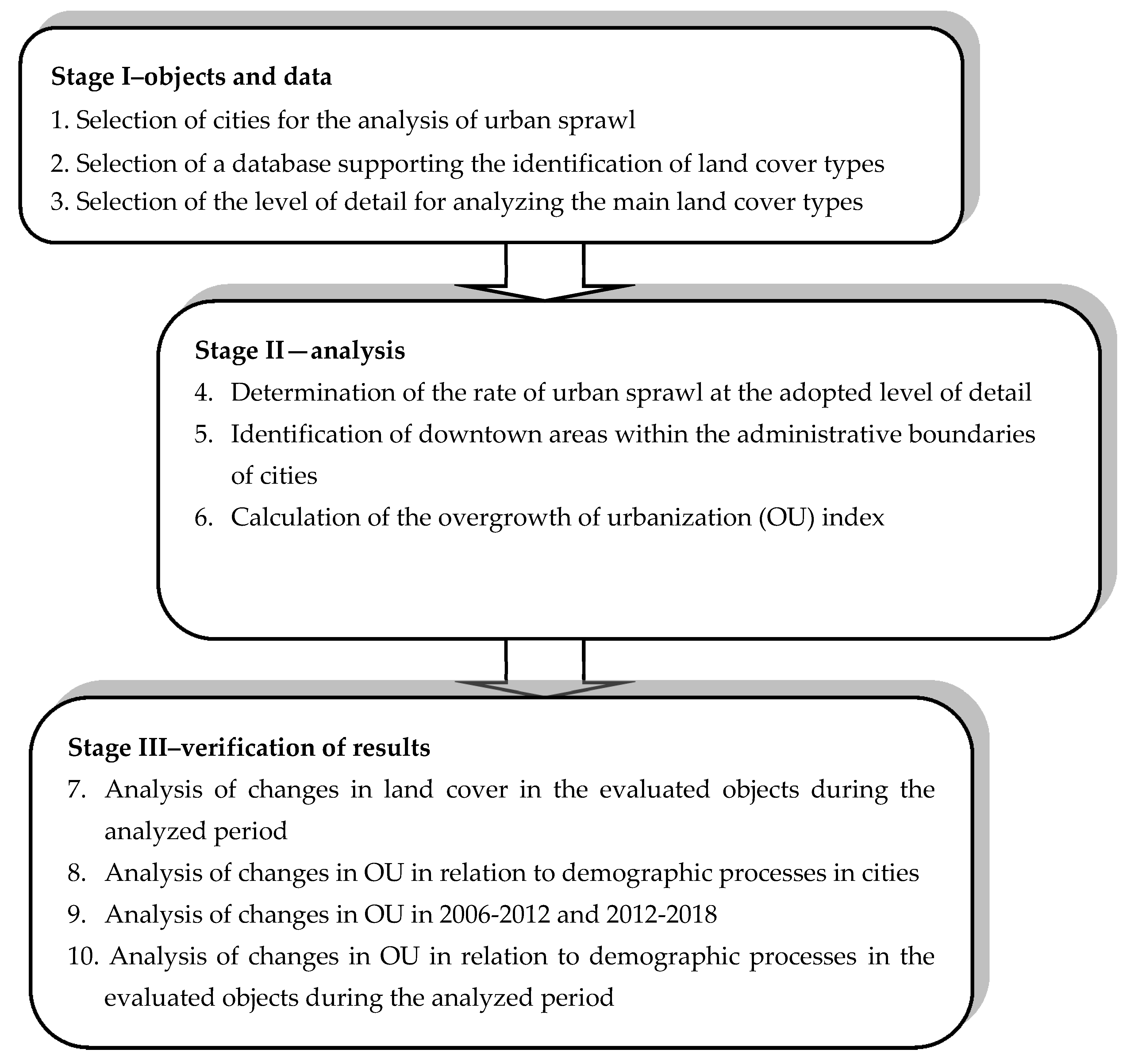

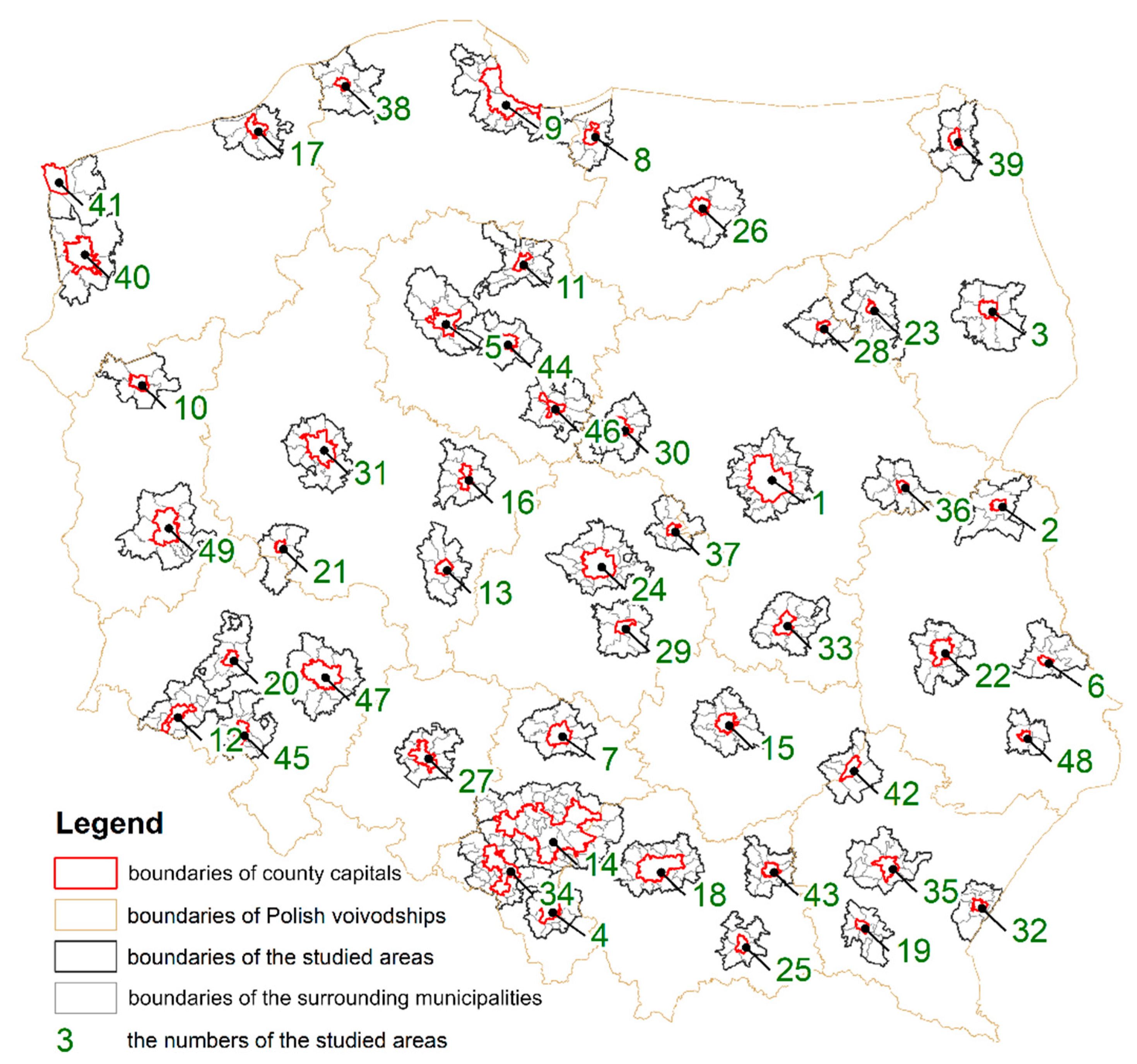
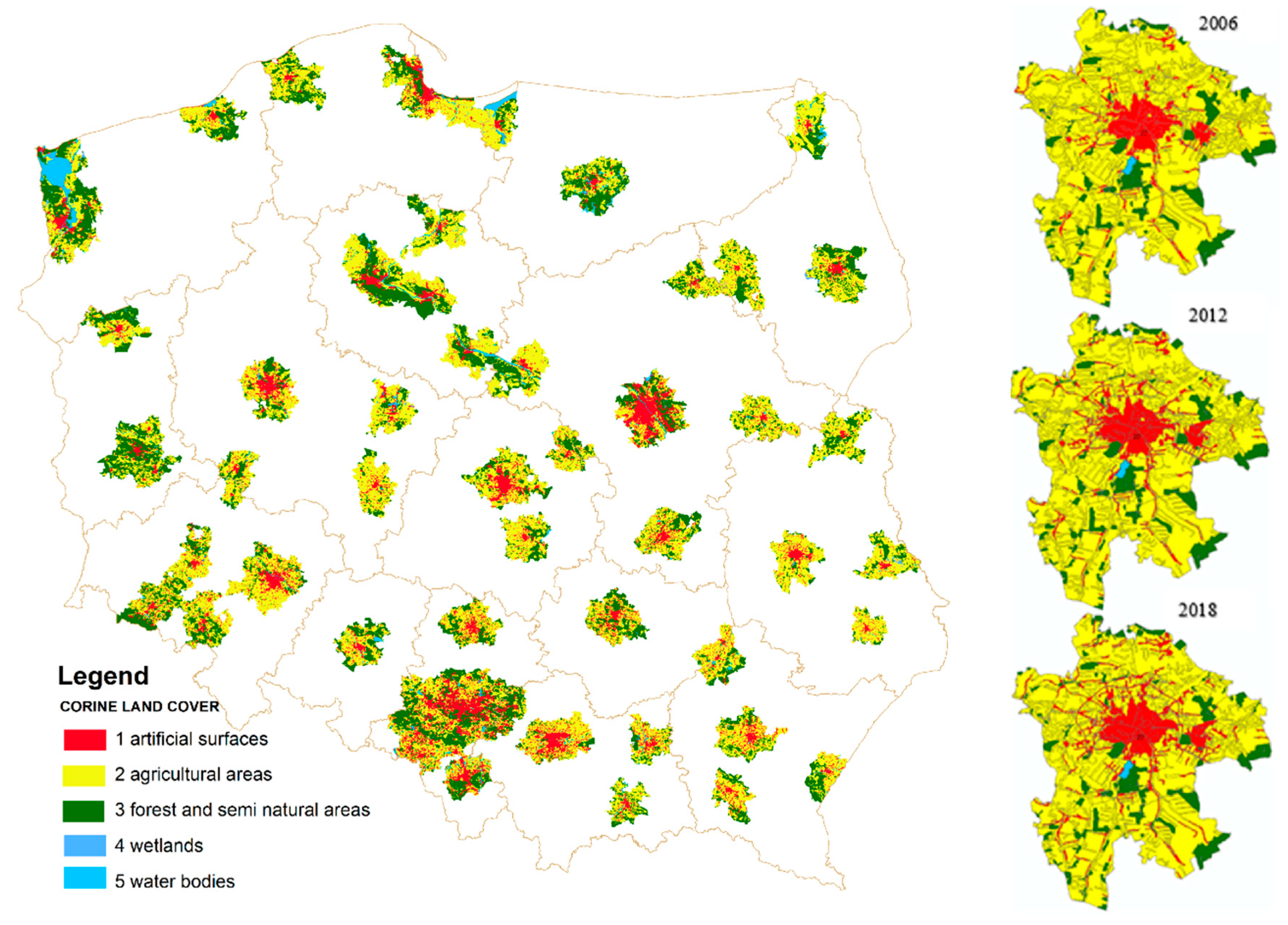
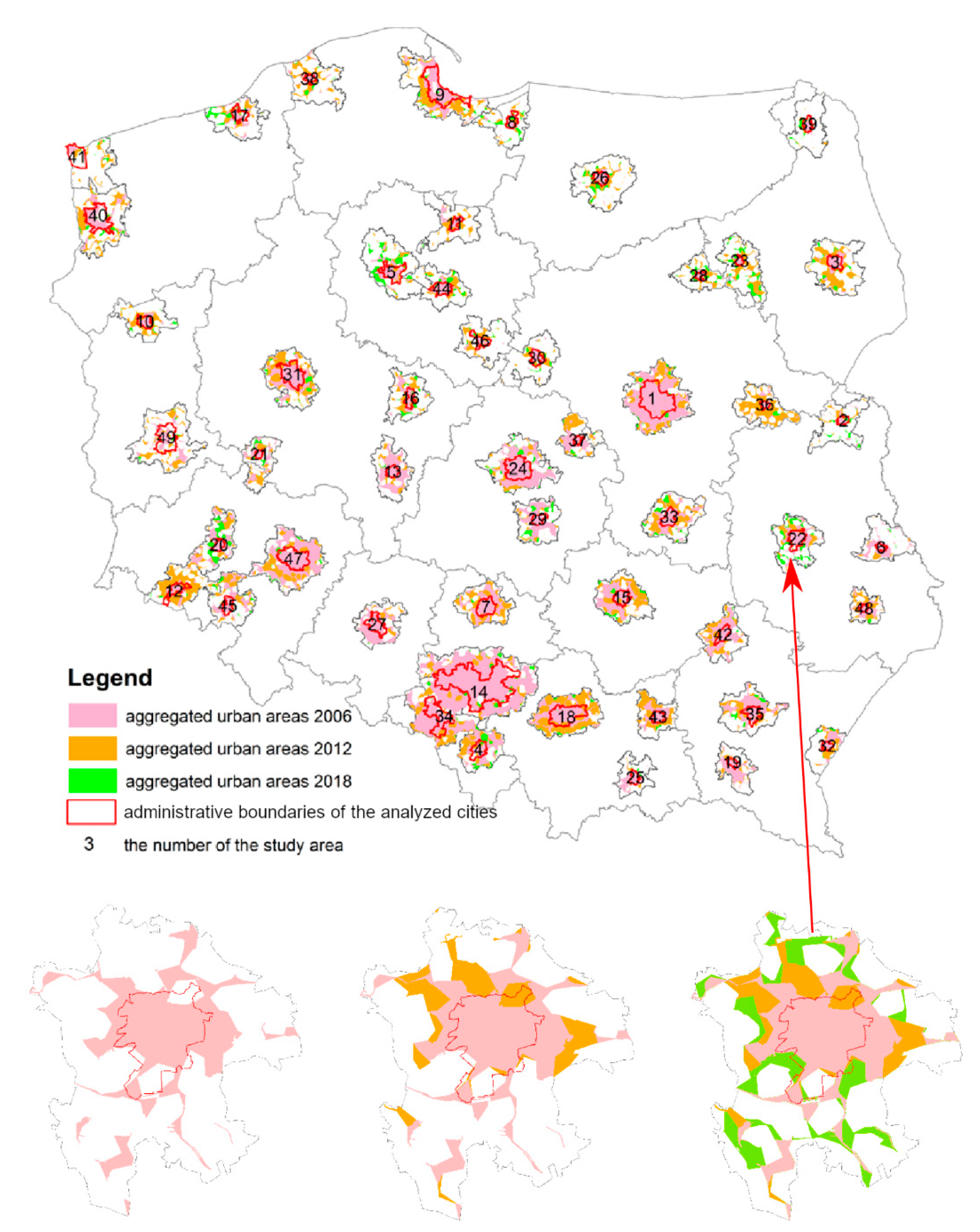
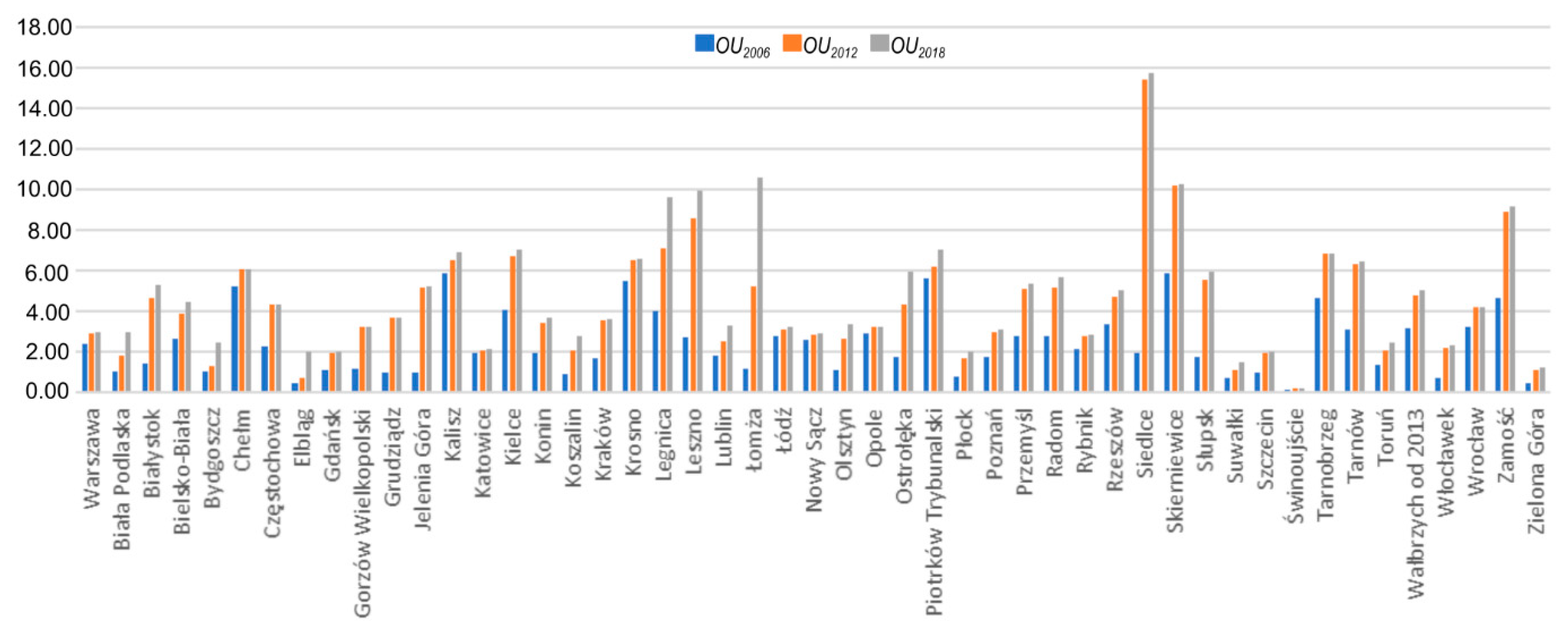


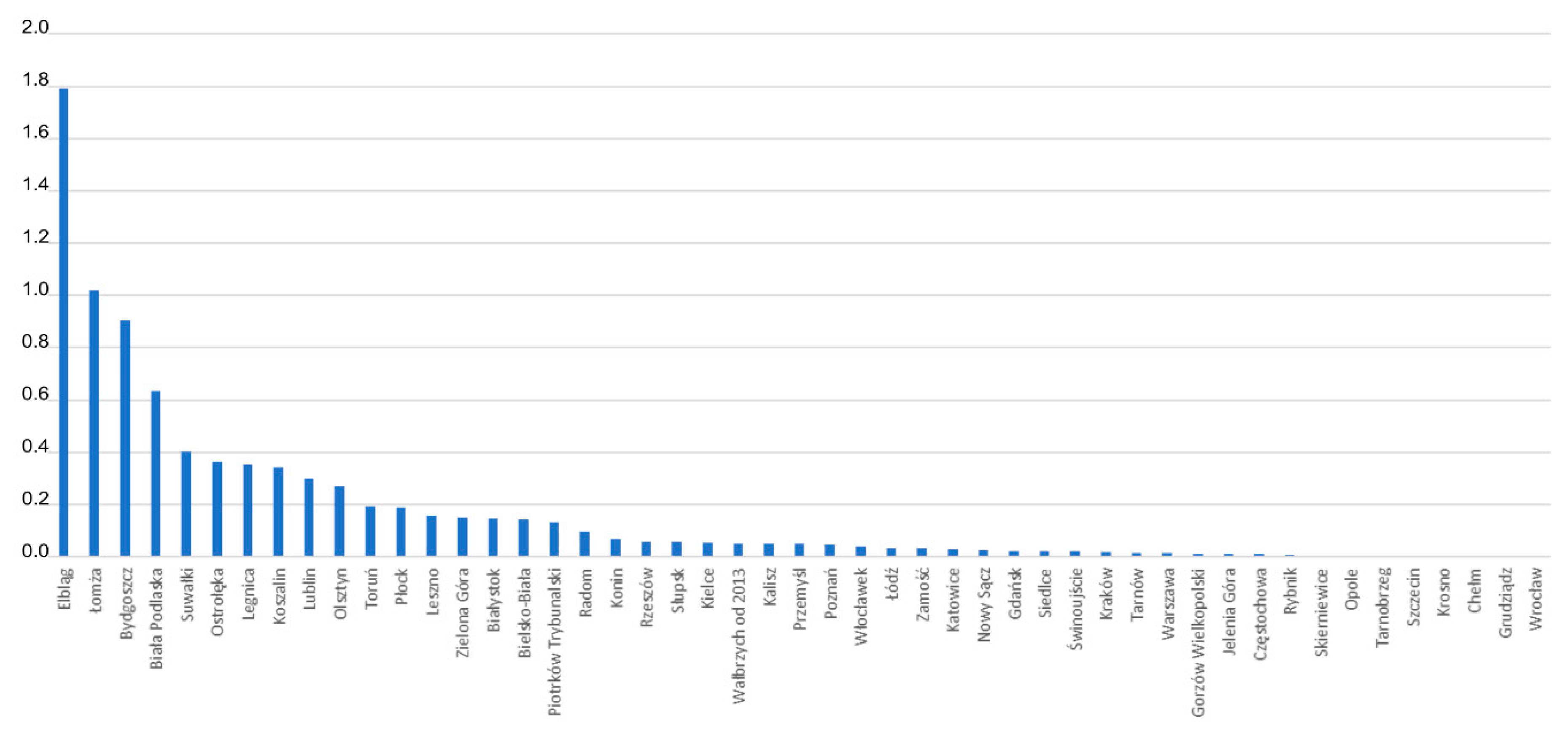

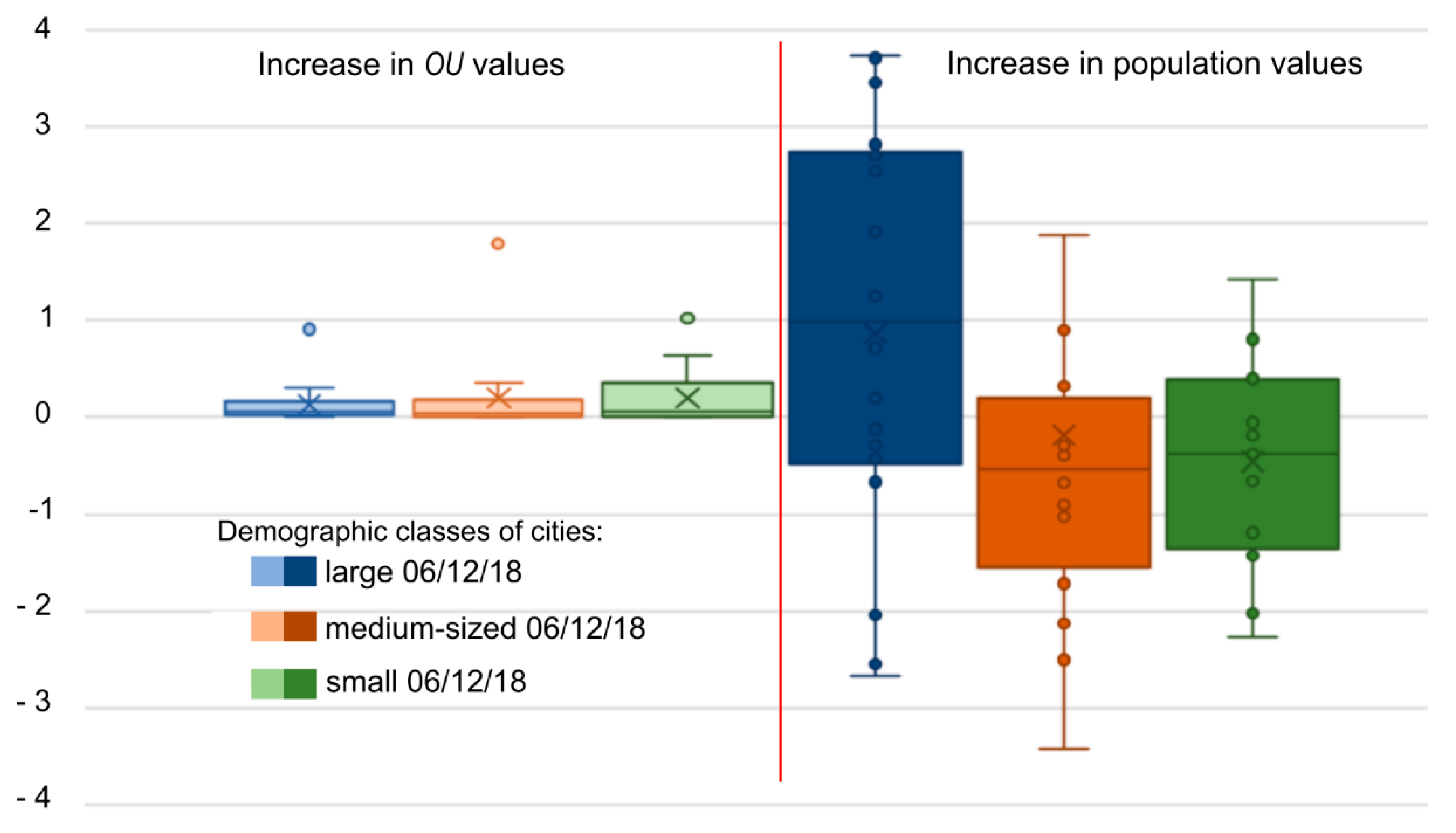
© 2020 by the authors. Licensee MDPI, Basel, Switzerland. This article is an open access article distributed under the terms and conditions of the Creative Commons Attribution (CC BY) license (http://creativecommons.org/licenses/by/4.0/).
Share and Cite
Cieślak, I.; Biłozor, A.; Szuniewicz, K. The Use of the CORINE Land Cover (CLC) Database for Analyzing Urban Sprawl. Remote Sens. 2020, 12, 282. https://doi.org/10.3390/rs12020282
Cieślak I, Biłozor A, Szuniewicz K. The Use of the CORINE Land Cover (CLC) Database for Analyzing Urban Sprawl. Remote Sensing. 2020; 12(2):282. https://doi.org/10.3390/rs12020282
Chicago/Turabian StyleCieślak, Iwona, Andrzej Biłozor, and Karol Szuniewicz. 2020. "The Use of the CORINE Land Cover (CLC) Database for Analyzing Urban Sprawl" Remote Sensing 12, no. 2: 282. https://doi.org/10.3390/rs12020282
APA StyleCieślak, I., Biłozor, A., & Szuniewicz, K. (2020). The Use of the CORINE Land Cover (CLC) Database for Analyzing Urban Sprawl. Remote Sensing, 12(2), 282. https://doi.org/10.3390/rs12020282






